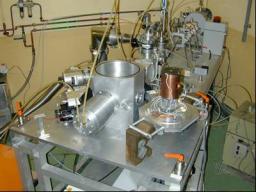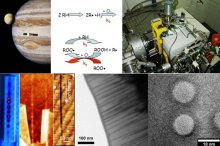 Durability and aging of materials
Durability and aging of materialsUnderstanding the mechanisms of materials aging in their operating environment, so as to predict the lifetime of the components or to optimize it, is an important issue of low carbon energies, whether it is nuclear energy (fusion , fission) or new energy technologies.
IRAMIS has a solid experience in the field of nuclear materials aging. It is based on its radiation stations (ions, electrons, gamma) and well-adapted characterization tools together with simulations, able to follow the structural changes and defects created. The materials studied are storage glasses, concrete materials or polymers used in the nuclear waste packages, ceramics, and steels (corrosion). Building on its experience and know-how in the nuclear field, IRAMIS develops research on the mechanisms of aging of materials for new energy technology, key point of their development: accelerated aging of electrolytes and battery electrodes, lifetime of solar cells used in space missions.
Research on this topic focuses on fundamental studies of the behavior under irradiation of a wide variety of materials used in the context of nuclear power (metal alloys, glass, ceramics, polymers). The experiments involve external irradiation tools (ion accelerators or electrons), and at the same time benefit from important simulation efforts.
The studies focus in particular on the microstructural evolution of the materials and the associated aging as well as the evolution of their properties which results (brittleness, resistance to corrosion, chemical reactivity ...), in relation to their potential uses.
Under irradiation materials and molecules undergo aging processes that must be mastered:
Particle-matter interaction: The collision of an ion with an atom, a molecule, an aggregate or a surface is the initial event of the processes leading to the various changes induced by the irradiations. At IRAMIS, the effects of multi-ionizations on the stability of matter are more particularly studied.
Materials under irradiation: Understanding the aging of materials placed in a radiative environment or modifying in a controlled way the properties of materials, are two axes of research at the heart of the CEA's priorities.
Radiolysis: The identification of physico-chemical processes induced by irradiation, as studied at IRAMIS, allows understanding many phenomena such as irradiation corrosion, radio-oxidation and the initial phases of radiobiological processes .
Sur ce thème, les objectifs de recherche portent sur la compréhension des processus actifs dans la matière lors des excitations électroniques et sur les défauts structuraux.
Les forces de cette thématique résident dans sa connaissance des processus d'excitation électronique couplant de manière unique des compétences en physique fondamentale des collisions et celles sur les défauts de structure dans les matériaux. Les recherches concernent donc les transferts d'énergie entre ions multichargés et des petits ensembles d'atomes, les voies de relaxation de cette matière excitée, les mécanismes de création de défauts, les modifications structurales induites par irradiation et la description des défauts de croissance ou d'irradiation. Cette thématique est en amont des recherches sur le vieillissement des matériaux du nucléaire.
De plus, cette thématique est en relation étroite avec l'activité d'accueil auprès du GANIL. En effet, beaucoup de ses résultats sont obtenus lors d'expériences réalisées grâce aux faisceaux du GANIL et de plus, ses chercheurs participent comme contacts locaux à cette activité d'accueil, mais aussi en développant des équipements qui sont ensuite mis à disposition des chercheurs extérieurs (Diffractomètre de rayons X en ligne, sources d'agrégats en sont deux exemples).
4 équipes de recherche du CIMAP travaillent sur cette thématique :
- Équipe AMA : "Atomes, Molécules et Agrégats"
- Équipe MADIR : "Matériaux, Défauts et Irradiation"
- Équipe SIMUL : "Simulation"
- Équipe ARIA : "Accueil et Recherche en Radiobiologie des Ions Accélérés"














